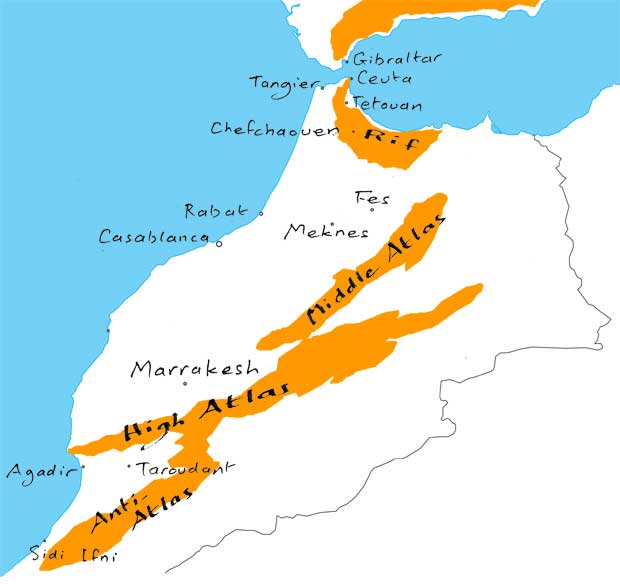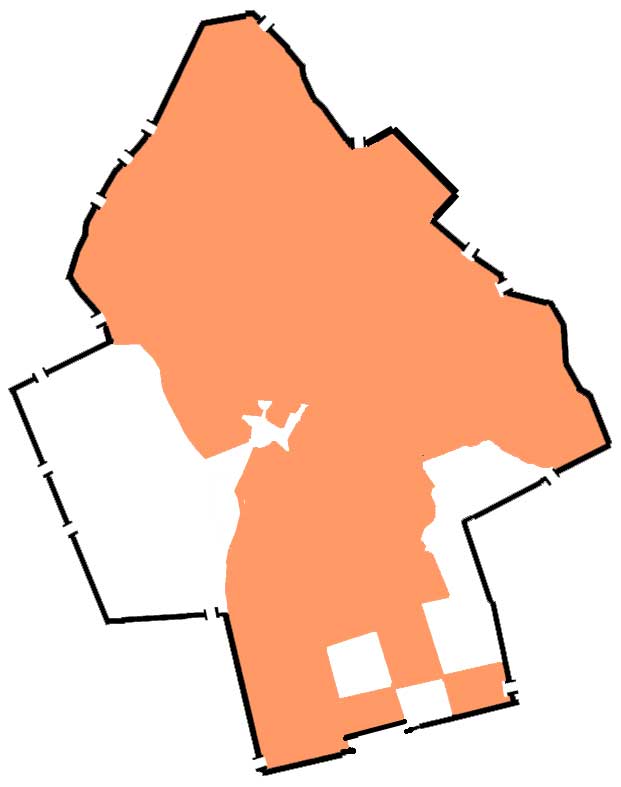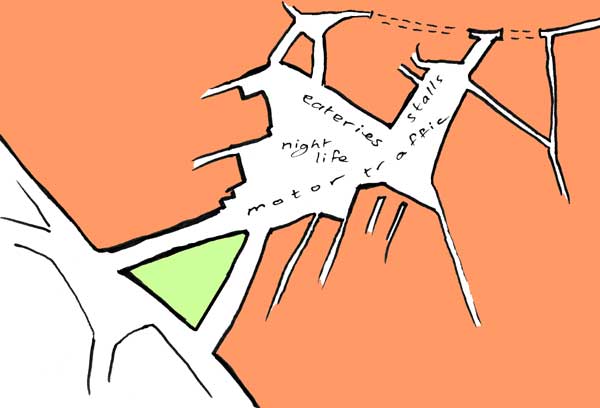|
Deep-Moroccan Marrakesh
Though Marrakesh is toward the south of Morocco, I first came to it from farther south, having hitchhiked around the end of the Atlas mountains and in along the Sous plain (where I lay naked on my sleeping bag to give insects maximum choice before stinging my eyelids). From Taroudant, having heard that few cars dared the road over the High Atlas to Marrakesh, I relented and took a bus; where it paused at a teahouse on the Tizi-N-Test pass, a German hitchhiker had been waiting for ten days — in those times young Germans were almost the only other travelers one met. The road wound down through forests to Marrakesh.

In 2006, budget airlines extended their destinations beyond Europe to Marrakesh, and I wrote a self-righteous letter to a British newspaper: “You report an EasyJet spokeswoman as saying that travellers are now 'more adventurous'. There is nothing adventurous about flying to Marrakesh. Air passengers effectively, and sometimes literally, sleep all the way. They have no idea of the ground they have passed over — its vastness, its details. They have not travelled. I got to Marrakesh by rail and hitchhiking . . . Even rail and hitchhiking were luxuries compared with the ways of real travellers in the past” (I was thinking of Ibn Battuta, who in the 1300s journeyed by foot and camel almost everywhere between his Moroccan home and China). “We have no natural right to see Marrakesh. We deserve it by travelling to it.”
Nevertheless, it was by EasyJet that I had to come to Marrakesh a second time. It was now popular with tourists, and even Taroudant was well prepared for them. Yet that road that twisted over the High Atlas was now regarded as so formidable that no bus or collective taxi would take it; the only way was back around the seaward end of the mountains.
The indigenous people of all northern Africa west of the Nile valley are the Berbers. There are several Berber languages; the chief one of Morocco is Shleuh, but in it the people call themselves Amazigh and their language Tamazight. Berber names on the map, like Timbuktu and Tlemcen and Tibesti and Tafingoult and Taroudant, often have “t” at the beginning or end or both (at the end it is the feminine marker, corresponding to the “-a” in Arabic which becomes “-at” before vowels). The Berbers became overlaid by the invasions of their distant Arab cousins and consequently became Muslim, so that now some of them still speak Berber and some Arabic and some both, and in cities such as Marrakesh you can't tell which people consider themselves Berber except by asking them.
Atlas may derive from a word for “mountain” in one of the Berber languages (in others it appears as different as idurar). The Atlas is a band of parallel fold-mountains composing northwest Africa. Morocco is the western third, where the Atlas system frays out in four ranges: the short Rif on the north coast (curling to the Strait of Gibraltar to meet its continuation in Spain), the Middle Atlas, the High Atlas, and then, beyond the plain of Sous, the geologically oldest, called Anti-Atlas. And south of that is the Sahara.
Marrakesh isn't at the foot of the High Atlas but about thirty miles out north from it. Compared with the surprising greenness of the Sous, at least in winter, the flat surroundings of Marrakesh are quite barren, and then from the mostly dry bed of the Tensift, which passes the city's northern end, an even more desert-like region extends for another sixty miles.
Marrakesh is one of Morocco's four historic capitals. The other three, Rabat, Meknes, and Fes, lie relatively close together in a line across the more fertile mid-north of the country. Marrakesh was the capital that faced south. In a small museum in it you can see impressive maps of the trade routes that radiated from it across the Atlas and on to the oases of the Sahara and all the way to the Niger and Nile valleys. (It is said that caravaneers after months of travel across these lonely wastes arrived in Marrakesh hungry for the hammams and for female company.) Now, seemingly, it has turned to facing north.
The city is Marrakesh in English or Marrakech in French. The country is Morocco in English, Maroc in French, Marruecos in Spanish, and Al-Maghrib in Arabic. In the time of the Roman empire it was Mauritania; its people were Mauri, later known in Spanish as Moros and in English as Moors. Are these names somehow derived from each other or are they a multiple example of linguistic convergence?
Well, the city may lie at the root. Though we say “MARR-a-KESH,” the people stress the vowel we don't: almost like “mr-RAA-ksh.” The origin may have been Berber, mur-n-akush, “land of God.” Maurus, Moro, Moor surely came from the same word for “land.” Marruecos, Maroc, Morocco are the name of the city generalized to the country. But Maghrib, which looks as if it might be some mix-up of the same consonants, is of unrelated origin. It means “place of sunset” and hence “the west” in Arabic (from the root gh-r-b, “to set”). The whole northwest of Africa is called by Arabs the Maghrib, but the kingdom of Morocco has appropriated it specially.
Marrakesh seems almost the creation of its central cavity. English lacks a good word for what it calls, often ridiculously, a “square.” The public space in a town is, after all, usually its heart. In Greek it was the agora; Latin, forum; Italian has one of the best words, campo; other European words are a bit less satisfactory, place, piazza, plaza, Platz; Persian calls a large square a maidān, “plain”; in Arabic, at any rate of Morocco, it's sāha (the h should have a dot under it to show it's the hot, pharyngeal kind of h).
The great sāha of Marrakesh is a public space like no other, and is less like a “square” than any other. It is called the Jemaa el-Fna, a slippery and mysterious and even sinister name. As written in classical Arabic (which Moroccan elides so much) it is Sāhat Jāmi’ al-Fanā'. The second word, from the root meaning “gather, put together,” could be jāmi’, meaning “place of assembly” or more specifically “mosque”; or it could be jamā’a, meaning “assembly, crowd.” The last word is apparently fanā', meaning “nonexistence, annihilation, death”; or it could be finā', meaning a space beside or in front of a building. And so there is room for speculation that the great space is so called because it was once a small space associated with a mosque that has vanished; or because it was where men were hanged.

Though the Jemaa el-Fna is the heart of Marrakesh, it is in a sense not at the center. It is about at the center of the oval bounded by the city wall, a jagged oval more than two miles long, within which lies the “medina.” (Madīnah means “city” but is usually applied to the older part, excluding modern sprawl.) But the medina mainly spreads from the Jemaa el-Fna to the north and east and south, as if it has grown from it in those directions, leaving on the west and southwest a large space that is within the walls but is mostly open, with parks and avenues (though containing major buildings, such as the great Koutoubia mosque); a space that touches the Jemaa el-Fna, giving it an opening to the country. Out on this side are the railway station and bus station and airport, and the roads to the coast and the other capitals.

The Jemaa el-Fna is huge, and in shape it can only be called a spiky amoeba. Blocks of shops stick into it; you go around corners of it and new spaces of it open up. It is divided, in no formal way, into regions; some regions are given over to market stalls and restaurants under awnings. A diagonal zone has cars swimming through it, able to get in from the country and as far as the entrances of streets. Other regions large and small are where acrobats form human pyramids, or musical bands perform at approximate competition-distance from each other, or scattered individuals beat drums, or at night circles of people gather on benches around lanterns.
At least a dozen streets sprout from the Jemaa el-Fna; some begin through arches in its sides, some are extensions of its sharp corners. The “square” seems to be made of many triangles, and at a western point it throws off another triangle, a bit of park between diverging avenues, on one of which the horse-drawn calčches wait; this is the opening to the wider open region.
The other streets plunge into the medina. Two kinds of street contrast in the older masses of this and other Moroccan cities. The thoroughfares, often still called “Rue,” spring from the corners of the Jemaa el-Fna. Those on the north pass into the souks, the markets, but all are densely lined with the little shops we call “hole-in-the-wall,” though that doesn't describe them: they are fathom-wide shops (a fathom is the span of the outstretched arms). They are varied by the occasional small mosque, or a rich shop prolonged back into a cave of carpets or jewelry; all are so festooned with their glittering wares that the stuff hanging on the wall-end between two shops could belong to either. There is so much that you pity the ever-waiting merchants; “How can it all ever sell?” The answer is: “There are just so many people!” — it's enough if one in a thousand buys something. These streets, though they are thoroughfares, are seldom wide, and in some places the corners of buildings constrict them to a fathom; they pass under arches, and sections are covered, like the souks, with awnings.
The thoroughfares are so crazily crowded that you have to laugh. Every few seconds you have to get out of the way of a motorcycle or bicycle; these stop-start through the throng as fast as they can, which can scarcely average faster than walking. Moments of paralysis occur when a hand-pushed cart carrying goods to a shop meets another carrying bricks or long pipes. The streets appear to be closed to cars and calčches, but this is because they are close to totally impracticable for large vehicles; a few, such as taxis, are hidden in garages from which they can get out in the very early uncrowded hours. There aren't wandering sacred cattle, as in Indian cities; there are numerous cats, deft at threading among the human legs, apparently well fed, some evidently resident at shops on whose counters they sit.
Off these busy streets branch the back streets, or alleys, called derb (a word that originally meant a path, a narrow trail in the mountains). They are suddenly quiet, and look like small canyons, having generally featureless walls sparsely punctuated by small barred windows and the doors of houses. The alleys turn some corners and throw off branches. When you look at a map of Marrakesh, you notice that these networks seldom reach through to another major street, and you may suspect that the mapmaker explored some way into them and gave up. But the alleys do almost all come to blind ends. If you want to find a short cut through from one Rue to another, there are a few alleys that will let you, but you are less than likely to find them. In effect each derb and its branches is the internal network of a neighborhood of residences.
The doors are wide apart, and some are masterpieces of decoration and iron-studded strength, because the houses to which they give admittance are large.
When on my earlier travels I lived in Fes and was invited into houses, I described them as “always the gorgeous fruit inside the crusty skin — the dirty gray wall looming over a narrow alley, the humble door to a passage bursting out into a garden of grass and palms surrounded by colonnade and spacious whitewashed rooms.” My ideal of furniture became what I called “Moroccan furniture”: a continuous couch around the walls of a room, with cushions and with curtained storage under, so that the room could entertain the maximum company of guests, partaking of the great dish of kouskous on low tables in front of them.
Arabic riyād means “gardens” (plural of rauda, as in the name of the capital city of Saudi Arabia: Al-Riyād, “the gardens.” (Again there should be a dot under the d to show it is a “hot” consonant, with the back of the tongue raised.) But in Morocco it has come to mean a traditional city house with at least one interior courtyard that is at least somewhat garden-like, and many of these houses are now converted into guesthouses of a gentler and more colorful kind than hotels; tourists are advised by their guidebooks of “riads” where they can stay. A prospering owner (perhaps French) of a riad will extend it by acquiring another house, and another, next to or behind it, so that it becomes a complex of courtyards in various relations, some with pools, connected by pillared spaces and laced with winding staircases and balconies and with extra apartments on the flat roofs — a maze in which you can lose your way back to the street door, and all pleasantly decorated with Moorish mosaics and wrought iron and rugs, and arches of the Moorish shape, like a round head on square shoulders.
Back
|



